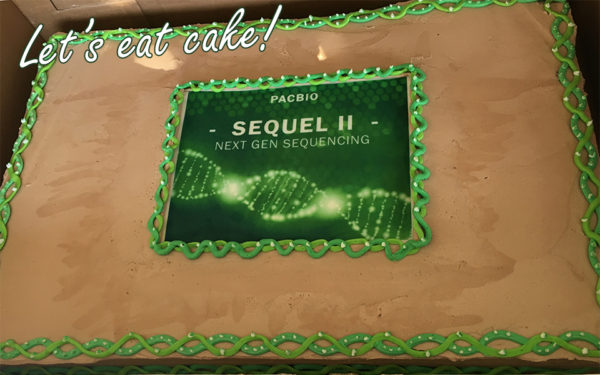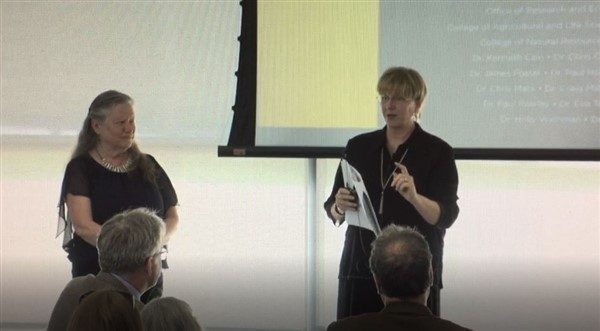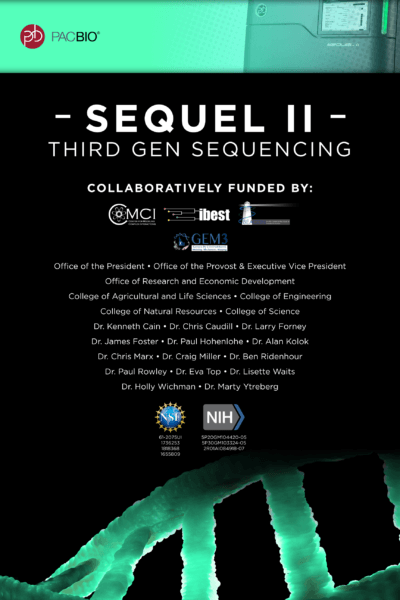
Yesterday, the University of Idaho took delivery of a just-released, state-of-the-art DNA sequencer: PacBio Sequel II. This instrument is one of the very first of its kind in the entire world. And because we are one of the first organizations to acquire the machine, it also means that we will be one of the very first organizations to have access to an immense amount of quality data, the likes of which has never been available on campus before. This creates a tremendous opportunity for researchers at the University of Idaho to innovate and leverage this new type of data, creating major impacts in their fields and doing things people have not yet even thought of.

Also significant is the fact that 23 different people and organizations across campus came together in just 3 weeks to collaboratively purchase the sequencer. No one department or faculty researcher could make such a large purchase on their own. But with everyone contributing bits and pieces of funding, a momentous opportunity unfolded.
Funding organizations and individuals include:
Center for Modeling Complex Interactions (CMCI)
Institute for Bioinformatics and Evolutionary Studies (IBEST)
BEACON Center for the Study of Evolution in Action
GEM 3 Genes by Environment
Office of the President
Office of the Provost & Executive Vice President
Office of Research and Economic Development
College of Agricultural and Life Sciences
College of Engineering
College of Natural Resources
College of Science
Dr. Kenneth Cain
Dr. Chris Caudill
Dr. Larry Forney
Dr. James Foster
Dr. Paul Hohenlohe
Dr. Alan Kolok
Dr. Chris Marx
Dr. Craig Miller
Dr. Ben Ridenhour
Dr. Paul Rowley
Dr. Eva Top
Dr. Lisette Waits
Dr. Holly Wichman
Dr. Marty Ytreberg

Vice President for Research and Economic Development Janet Nelson announced the arrival of the Sequel II at the SAS Talks yesterday in the IRIC:
How long do you think it took and how much do you think it cost to generate the first sequence of a human genome? It took 13 years and $3 billion! Tonight’s theme is public impact research, and from that perspective this was one of the most important scientific achievements of its time. Like many important milestones in science, the technological by-products of the quest are as important at the achievement itself. The moon landing gave us Velcro; deciphering the human genome gave us next-generation sequencing technology. Today the University of Idaho took delivery on the just-released, state-of-the-art, DNA sequencer—PacBio Sequel II.
Why is this important for Idaho?
First, this is a game changer in the field of genomics and will allow us to continue our tradition of high impact research. With this instrument it will take less than a week and cost about $5000 to sequence a human genome, and the quality of both the sequence and the assembly will be vastly superior to the $3 billion genome released 16 years ago. The new PacBio will have applications in many fields, including medicine, natural resources, and agriculture, to name a few.
Second, the University of Idaho is one of the first institutions in the world to take delivery of this new instrument, putting us on the cutting edge of genomic sequencing technology. This will allow our Genomics Resources Core to continue to provide the value-added service for which it so well known. It will improve research at the University of Idaho and across the state, creating a tremendous opportunity for our researchers to lead the world in integrating this new type of data into our research programs.
Finally, this purchase is concrete evidence of what we can achieve by working together. In just over a month, we brought together 23 contributors to purchase this machine and an extended service contract. This is the largest number of contributors to come together so quickly for a purchase of this type– at least that I am aware of. Let’s take a moment to celebrate what we can do through cooperation and collaboration.
The Sequel II will be managed by the IBEST Genomics Resources Core located in IRIC.
